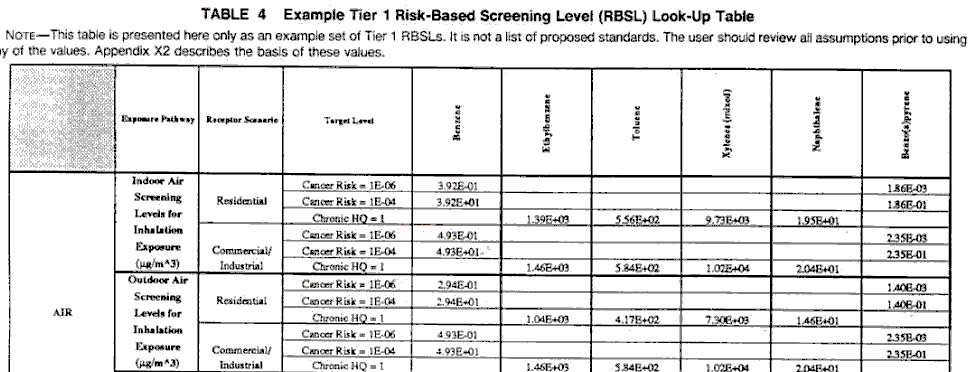
While the RBC represents a valiant effort on the part of a few individuals in the EPA, the RBCA (pronounced "Rebecca") is the fruition of years of hard work by the American Petroleum Institute (API) and the American Society for Testing and Materials (ASTM). The full title of the document is "Emergency Standard Guide for Risk-Based Corrective Action Applied at Petroleum Release Sites." Its designation is E1739-95 (Reapproved 2015).
If you are a UA student, you can get your own copy of the publication. Go to the library main page and ASTM in the databases. But here are the key points:
RBCA uses the concepts of TIERs. The first Tier is very similar to RBC. RBCA requires an evaluation of the contaminant, transport, SCEM, receptors, etc., and then you are able to compute look-up tables, RBSLs, risk based screening levels, that are similar to RBC, and likewise based on very conservative assumptions. If the contaminant is less than the RBSL table, you should be able to walk. Also, if the contamination can easily be cleaned up to below the table value, you should do that, then walk. Tier 1 also suggests that you calculate the cost of doing a real risk assessment, and if the cost of cleaning up is less than the cost of the full risk assessment, then you should clean the site (to the levels in the table) rather than spend the money on the risk assessment.
In order to use the table, you need to do a site assessment and develop a SCEM in order to know which section of the tables to use. Here is an excerpt for review purposes from the RBCA table from an older version of the standard - but you get the idea:

Note that it only covers six chemicals: the four BTEX volatiles, the semi-volatile Naphthalene, and the nonvolatile Benzo(a)pyrene. In general these are the most common chemicals of concern at petroleum spills and petroleum contaminated sites. If these are below the RBSL table, the site is likely clean enough.
Tiers 2 and 3 involve more risk management, but basically Tier 2 involves determining some compliance point (often the property line), and again determining if the contaminant is likely to be less than the RBSL at the compliance point. Tier 3 is just the risk assessment as you have been learning, with the exception that if cleaning the RBSLs is cheaper than proceeding to the next tier, you should just clean to the RBSL.
The RISC program has a similar table for many more chemicals. It's derivation is described in Chapter 2 of the RISC manual (a pdf file you have now). Basically, the authors of the RISC program used the RBCA assumptions to develop of table of screening levels. You should see a file with these tables by just clicking the Tier 1 Levels button from the RISC main menu. You can also get the files easily by finding the location of the RISC program files, mine are in a folder on my C drive labeled "risc4" and the file is TIER1.xls. You can choose the level of cancer risk and other parameters and the Excel sheet will recalculate them.
In summary, both RBC and RBCA publish very conservative numbers, such that, with adequate sampling and analysis, if you determine the contamination at your site is less than the level stated in the table, you should not have to do anything further on the site. If it is feasible to clean up to the RBSL, you should do that, rather than a complete risk assessment. End of Sub-module 9B. BACK
ENVE 651 Homepage Module 9 Index